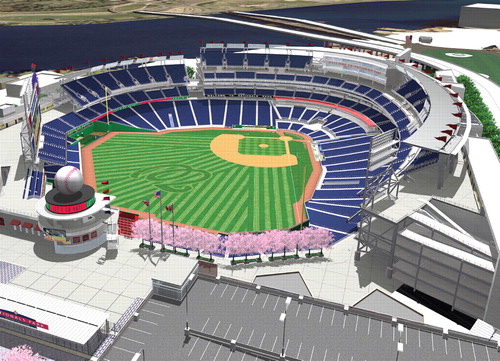D.C.'s Latest Baseball Team to Unveil New Home
“Washington—first in war, first in peace, and last in the American League.”
A century has passed since sportswriter Charlie Dryden penned that immortal parody about the old Washington Senators, and still baseball fans in the nation's capital suffer. The only difference is that the new Washington Nationals are now in the National League and clawed their way up to fourth place last summer, one slot above the cellar.
Historically, the one thing grimmer than sitting for three hours in Washington's trademark summer humidity was watching the team on the field. Of course, the diehards will tell you that there is one thing even worse—not having any baseball at all, an affliction the city endured for more than 30 years.
Real oldtimers will recall that the Senators, the team Dryden first covered, managed to win just three pennants and one World Series (in 1924) from its birth in 1901 until the team shuffled off to become the Minnesota Twins in 1961.
Some claim that the best baseball played in Washington over that stretch came at the hands of the Homestead Grays of the negro leagues. Nominally based in Pittsburgh, the Grays used D.C.'s Griffith Stadium as a second home field, where fans could watch legendary sluggers like josh Gibson and Buck Leonard power the team to nine Negro National League pennants in the 1930s and 1940s.

A second Senators franchise in the 1960s lasted only 10 years before it too left town in 1971 and morphed into the Texas Rangers, a team with its own problematic history. Attendance was low for both incarnations of the Senators, because performance on the field was so miserable and management was so unwilling to market the team.
It was enough to make selling your soul to the devil in exchange for a pennant look attractive, as the authors of the show “Damn yankees” suggested.
During the ensuing drought, fans and local politicians moaned about the lack of a hometown team. Members of Congress rumbled about rescinding major league baseball's antitrust exemption. Desperate for a fix, baseball junkies made the trek up I-95 to Baltimore to see the orioles play, a fine alternative in the late 1970s and early 1980s but less aesthetically attractive over the last decade.
Eventually, baseball's failure to take root in Montreal turned that city's expos—who sometimes seemed to have more people in the dugouts than in the stands—into the new Washington Nationals before the start of the 2005 season.
For a while that year, hope bloomed like the cherry blossoms in spring, as the Nats got off to a 52-36 start under manager Frank Robinson, good for first place in the National League East. The team seemed to find a new way to win each night. Come-from-behind victories became standard. Even the most cynical lobbyist came to see the concrete confines of RFK Stadium as a field of dreams.
But like the cherry blossoms, the team's performance dropped off, tanking to an 81-81 season record and last place in the division. The nats have been in relapse ever since.
Yet baseball is a sport where hope is renewed every year. Spring training has an amnesiac effect, gently excising memories of the previous year's failings. The slate is wiped clean. Old players depart over the winter, new ones arrive, and possibilities abound.
Nats' general manager Jim Bowden spent this winter rebuilding the club. He picked up catcher Paul LoDuca, who hits well and calls a solid game, and infielder Aaron Boone, a veteran who may bring some stability and direction to the clubhouse.
In December he traded 13-year team veteran catcher Brian Schneider and outfielder Ryan Church to the New York Mets for 22-year-old outfielder and rap singer Lastings Milledge.
A few days later, Bowden swapped a minor league pitcher for Elijah Dukes, a 23-year-old outfielder with a rap sheet longer than Milledge's rap song. Bowden and second-year manager Manny Acta concede that Dukes is a project, but that with close guidance, his talents on the field may overshadow his past lapses of judgment off it.
The Nationals have another asset not readily available to most teams. Many of the people living in the Washington area grew up somewhere else and retain loyalties to their old hometown teams. They fill seats that might go unoccupied while the Nats build their local fan base.
The Nationals have been building more than a roster.
Nationals Park, the team's new home, sits one mile south of the U.S. Capitol along Washington's developing Anacostia River waterfront, with views of the Capitol and the Washington Monument.
The stadium is now a construction site, but city and team officials promised that it would be ready at the time this issue went to press. Nationals Park will feature the asymmetrical design and multiple angles common to many new parks. The 41,222 seats are subtly oriented toward the infield, and half are accessible from street level, thanks to a field set 24 feet below grade.
Of course, those will be for regular fans. The lobbyists and fatcats will get to entertain clients and congresspersons in luxury suites named for Washington, Jefferson, and Lincoln.
Whether a new home will inspire this year's nationals to greater achievement on the field remains to be seen, but it may not matter. New stadiums always draw crowds, and these crowds have waited long enough to cheer.
Information on the Washington Nationals is posted at<http://nationals.mlb.com>.▪



